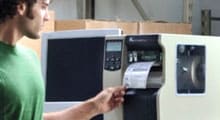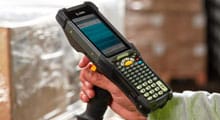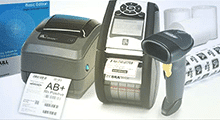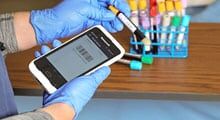About the Company
Hollister Incorporated is an independent, employee-owned company that develops, manufactures and markets healthcare products, primarily in ostomy care, continence care, breastfeeding, wound care and hospital risk management.
Business Challenge
When Hollister originally migrated from plant-based distribution to a central distribution center, management sought improvements in productivity, inventory efficiency and order fulfillment accuracy. “The biggest problem was the manual nature of the transactions,” Hourigan said. “The entire system ran on paper, which meant that a high proportion of our staff was dedicated to data entry. We felt that the logical sequence was first to get our ERP system running efficiently. The next step would be utilizing radio frequency for automated data collection that would later evolve into a full-blown labor management system. “We selected Peak Technologies based on their experience in implementing RF systems in all sizes of distribution centers and manufacturing plants, as well as their expertise in interfacing with SAP. In addition, we felt that Peak Technologies’ strong European presence would be very useful as we expanded the implementation worldwide. PeakRyzex’s systems requirements definition process not only provided a platform for developing a very effective design but also provided the answers we needed to get approval for the investment.
The Solution
The process defined jointly by Hollister and Peak Technologies begins when goods are delivered from the manufacturing lines to the plant’s shipping dock. The shipping crew scans each product as it is placed on a pallet, and the system automatically generates a barcoded label called a license plate that is affixed to the pallet’s shrink wrap. As the forklift driver loads the pallets onto the truck, they scan each of the license plate tags. When the truck is full, the user performs a “door close” transaction on the Symbol handheld that creates an electronic manifest. The electronic manifest automatically transfers the finished goods from manufacturing to an in-transit status for the distribution center. When the truck arrives at the distribution center, the forklift operator scans the license plate of each pallet which generates a hard copy printout, called a move ticket, for each of the different SKUs on the pallet and posts the receipt directly to SAP. The pallets, which contain between one and six SKUs, are broken down by like SKUs. The system provides authorization through the Symbol terminals to move the goods from the receiving dock to storage racks. Random putaway by like product is used so the user can select the most convenient storage rack to place the goods.
As the operator puts the product into the storage rack, they can scan the move ticket and the bin location, then enter the quantity of product being placed in that specific bin. The product immediately appears as being available for sale in SAP.
The next step is to replenish the pick faces used to supply the goods for filling customer orders. At predetermined intervals, the ERP system runs a job that compares the amount of inventory in the pick faces to predetermined minimum and maximum levels. If the amount of inventory is below the minimum, SAP automatically generates a replenishment transfer order. When the material handler logs in or finishes a job, Peak Technologies’ Interface searches SAP and displays the next 10 replenishment transfer orders. The orders are automatically sorted into the most efficient pick path. The forklift operator picks each item, scans the product and the bin location, which automatically updates the bin inventory in SAP. Once all the items are picked for those 10 replenishment orders, the Zebra terminal automatically arranges the putaway task in the proper order so that the last item picked will be the first item dropped off at the pick face. The operator scans the product and the pick face location as they are putting the item away and the terminal again notifies the operator if an error is made. As each item is dropped off at the pick face location, the transfer order is automatically posted and SAP is updated in real time. After the orders are picked, the product is sent to the packing areas via conveyors. The packers scan the product as they load each item into a specific carton. The terminal communicates with the ERP system to produce an advance ship notice and print a carton label with a unique ID generated by SAP for each carton. The cartons are then moved to the metering station, weighed and address label applied. The handheld terminals are also used for several other transactions. A material location inquiry screen lets an operator type in a material number to list the quantity and the location of the material. This transaction is used mainly to query for like material that can be consolidated to maximize warehouse capacity. When like material is located that can be consolidated, the user performs a “bin-to-bin” RF transaction. The user scans the material and bin location from which the product is removed, and then scans the bin where the product is placed. A transfer order is automatically created and confirmed in SAP. Once again, the inventory is immediately updated in SAP to provide real-time inventory visibility.
The next step is to replenish the pick faces used to supply the goods for filling customer orders. At predetermined intervals, the ERP system runs a job that compares the amount of inventory in the pick faces to predetermined minimum and maximum levels. If the amount of inventory is below the minimum, SAP automatically generates a replenishment transfer order. When the material handler logs in or finishes a job, Peak Technologies’ Interface searches SAP and displays the next 10 replenishment transfer orders. The orders are automatically sorted into the most efficient pick path. The forklift operator picks each item, scans the product and the bin location, which automatically updates the bin inventory in SAP. Once all the items are picked for those 10 replenishment orders, the Zebra terminal automatically arranges the putaway task in the proper order so that the last item picked will be the first item dropped off at the pick face. The operator scans the product and the pick face location as they are putting the item away and the terminal again notifies the operator if an error is made. As each item is dropped off at the pick face location, the transfer order is automatically posted and SAP is updated in real time. After the orders are picked, the product is sent to the packing areas via conveyors. The packers scan the product as they load each item into a specific carton.
The terminal communicates with the ERP system to produce an advance ship notice and print a carton label with a unique ID generated by SAP for each carton. The cartons are then moved to the metering station, weighed and address label applied. The handheld terminals are also used for several other transactions. A material location inquiry screen lets an operator type in a material number to list the quantity and the location of the material. This transaction is used mainly to query for like material that can be consolidated to maximize warehouse capacity. When like material is located that can be consolidated, the user performs a “bin-to-bin” RF transaction. The user scans the material and bin location from which the product is removed, and then scans the bin where the product is placed. A transfer order is automatically created and confirmed in SAP. Once again, the inventory is immediately updated in SAP to provide real-time inventory visibility.
Download the PDF Version
Click the download button below to download the PDF version of this case study to save or share.

Hollister Incorporated
Industry:
Medical Product Manufacturing
Business Challenge:
- Operating in a paperfree environment
- Bring warehouse operational
accuracy and efficiency up to
world-class
Solution:
- SAP inventory system
Key Benefits:
- Increased productivity
- Decreased costs
“We selected Peak-Ryzex based on their experience in implementing RF systems in all sizes of distribution centers and manufacturing plants, as well as their expertise in interfacing with SAP."
- Craig Hourigan, Manager of Supply Chain Logistics, Hollister
Benefits and Results
The success of this project can largely be attributed to the project management structure that Hollister and Peak Technologies jointly put into place at the beginning of the project,” Hourigan said. “Peak Technologies created a technical project plan that provided the perfect complement to our internal project team. We had weekly communications meetings throughout the project where we measured our progress, talked about questions and concerns, and made changes to the plan where necessary. Working closely together, we delivered the project on time and on budget. In the first two months of operation, we’ve already achieved our targeted cost savings. For example, we have eliminated two full-time positions that were required in the past to manually enter incoming shipments and replenishment orders. The RF terminals virtually eliminate the previously common error of putting items in the wrong bins. This has removed the need for what used to be a full-time problem resolution position and also saved a considerable amount of time that the forklift operators also spent trying to find misplaced products. With RF, we have improved the dock to order cycle by 50 percent from 10 to 5 hours. The near elimination of errors and the fact that a product now appears in inventory as soon as it goes on the shelf has helped to improve our fill rate to 97.8 percent, improved customer service and eliminated the need for double-handling. The project has been so successful that we are already in the process of rolling out the same system to our European distribution center and with Peak Technologies’ assistance are evaluating manufacturing as well.”


























